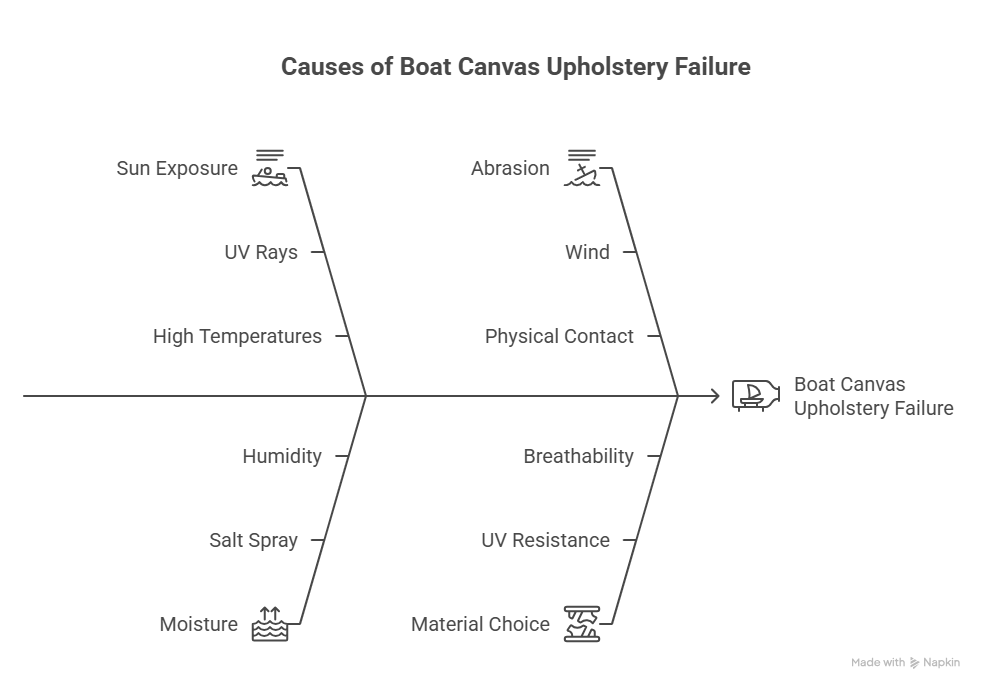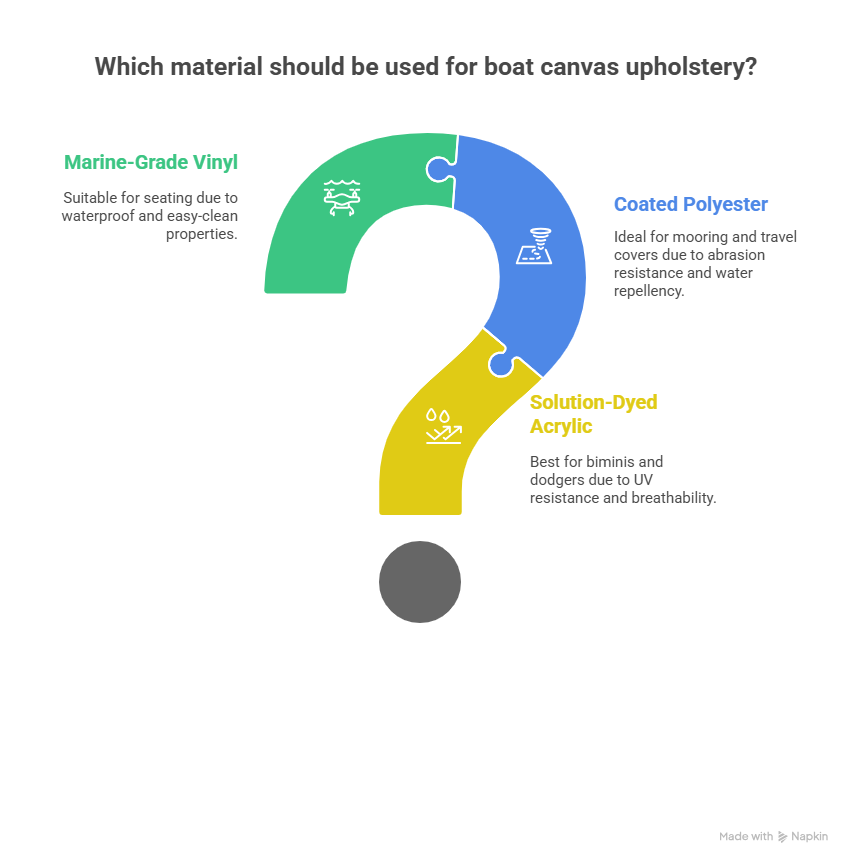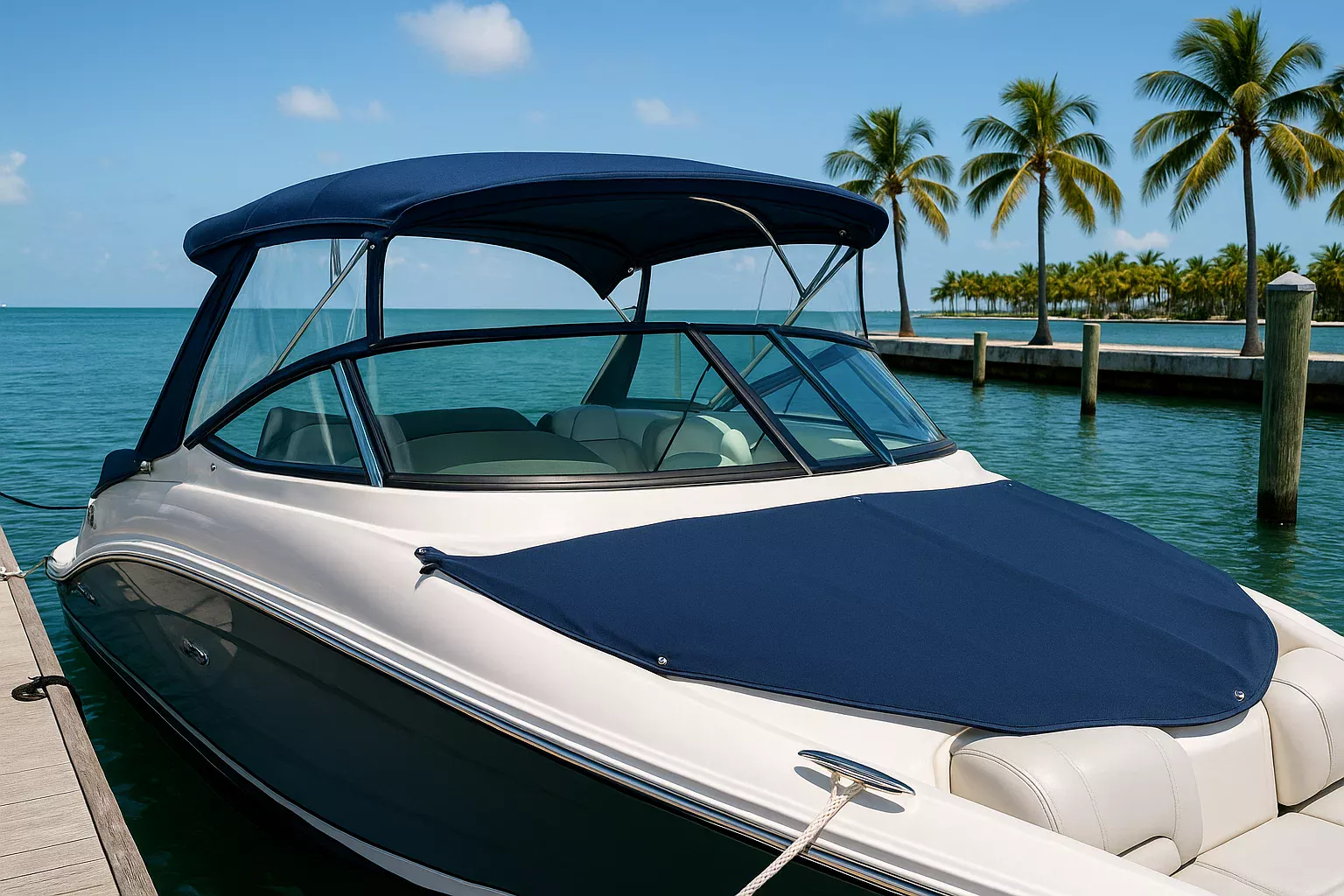Boat Canvas Upholstery: 15 Years of Stitches, Sun, and Saltwater Wisdom
I’ve been stitching and fitting boat canvas upholstery in South Florida for 15 years, from Miami’s Dinner Key Marina to Fort Lauderdale’s Bahia Mar. The sun, salt, and storms here don’t mess around, and neither should your canvas. Last June 2024, a client named Javier rolled up with his Sea Ray 350, its bimini top faded to a sad gray and seams splitting like a bad joke. Cost him $1,200 to replace—could’ve been avoided with the right choices upfront. Here’s what I’ve learned about picking and maintaining boat canvas upholstery to keep your boat sharp and protected without burning cash.
Table of Contents
Why Does Boat Canvas Upholstery Fail?
Boat canvas upholstery isn’t just about looking good—it’s your boat’s shield against sun, saltwater, and wear. Pick the wrong material or skimp on details, and you’re replacing it in a year. I’ve seen it too many times: a shiny new cover turns chalky, or mildew creeps in like an uninvited guest. Understanding the marine environment’s brutality—UV rays, humidity, and abrasion—is the first step to choosing wisely.
What Makes the Sun So Brutal to Canvas?
South Florida’s sun is relentless, baking your boat at 90°F+ daily. UV rays don’t just fade colors; they break down fibers, leaving canvas brittle. I once saw a client’s dodger on a Boston Whaler shred after one season because it wasn’t UV-resistant. Solution-dyed acrylics, like Sunbrella, lock color into the fiber, not just on the surface—think 10+ years of vibrant blues versus a year of washed-out gray.
How Does Moisture Wreck Upholstery?
Salt spray, rain, or even morning dew in Miami’s humid marinas can soak canvas, breeding mildew. I helped a guy named Maria at Key Biscayne last summer whose cockpit cushions were green with mold—$800 to replace because the fabric trapped moisture. Breathable materials like acrylic let water vapor escape, preventing rot, while vinyl’s waterproof nature is perfect for high-traffic seats.
Why Is Abrasion Such a Big Deal?
Canvas faces constant abuse—wind whipping a bimini at 30 knots, mooring covers rubbing against cleats, or passengers grinding sunscreen into seats. A weak fabric tears fast. Last month, a client’s travel cover on a Grady-White 208 ripped at highway speed—$500 fix. Coated polyester’s tear strength is a lifesaver for covers, while vinyl holds up to heavy foot traffic.

What Are the Best Materials for Boat Canvas Upholstery?
Choosing the right material for boat canvas upholstery isn’t about one “best” fabric—it’s about matching strengths to the job. Here’s a breakdown of the top options, based on jobs I’ve done across South Florida.
Table: Boat Canvas Upholstery Materials Comparison
I put this table together from projects I’ve tackled in Miami and Fort Lauderdale:
| Material | Best Use Case | Key Strengths | Cost Range | Lifespan |
|---|---|---|---|---|
| Solution-Dyed Acrylic | Biminis, dodgers, exposed cushions | UV resistance, breathability | $30–$50/yard | 10+ years |
| Coated Polyester | Mooring/travel covers | Abrasion resistance, water repellency | $15–$25/yard | 7–10 years |
| Marine-Grade Vinyl | Helm seats, cockpit cushions | Waterproof, easy to clean | $20–$40/yard | 5–8 years |
Why Choose Solution-Dyed Acrylic?
Solution-dyed acrylic, like Sunbrella, is my go-to for biminis and dodgers. Its color is baked into the fiber, not coated on, so it laughs off UV rays. I fitted a Sunbrella bimini on a client’s Yamaha SX210 in 2019—still looks brand new. It’s breathable, preventing mildew, but it’s pricier—worth it for exposed areas.
When Is Coated Polyester the Right Pick?
Coated polyester, like Top Gun, is a beast for mooring or travel covers. Its acrylic coating shrugs off abrasion and wind. Last July, I repaired a Top Gun cover for a guy at Stiltsville after it survived a 60-mph highway haul—$200 fix versus a $1,000 replacement. It’s less breathable, so vents are key to avoid moisture traps.
What Makes Marine-Grade Vinyl Ideal for Seating?
Vinyl’s a workhorse for cockpit seats or helm cushions. It’s 100% waterproof and wipes clean—perfect for fish blood or sunscreen spills. I swapped vinyl seats on a client’s Sea Ray 230 last spring; took 30 minutes to clean after a kids’ juice spill. It gets hot in the sun, so I pair it with acrylic backrests for comfort.
How Do You Match Fabric to the Job?
The trick to great boat canvas upholstery is picking the right material for each part of your boat. A bimini’s needs are worlds apart from a mooring cover’s.
What’s Best for Biminis and Dodgers?
Biminis and dodgers live in the sun, so UV resistance and breathability are non-negotiable. Solution-dyed acrylic is king here—its fade-proof fibers and airflow keep your boat cool and sharp. I fitted a Sunbrella dodger on a client’s Grady-White at Coconut Grove in 2023; still vibrant despite daily sun.
What Works for Mooring and Travel Covers?
These covers take a beating—wind, road grit, cleat chafing. Coated polyester’s tear strength and water repellency make it ideal. I saw a polyester cover save a client’s boat during a Miami storm last August—no leaks, no tears, $0 damage. Just ensure proper venting to avoid mildew.
How Do You Upholster Cockpit Seating?
Seating needs durability and comfort. I use a hybrid approach: vinyl for seat bottoms (waterproof, easy-clean) and acrylic for backrests (breathable, soft). A buddy at Dinner Key saved $500 by reupholstering his helm seat this way—looks pro, feels great.
Why Do Threads and Hardware Matter for Boat Canvas Upholstery?
The best fabric fails if the seams or snaps give out. I learned this the hard way in 2012 when a client’s bimini split at the seams—$600 redo. Threads and hardware are the backbone of your canvas.
What’s the Best Thread for Marine Canvas?
Standard polyester thread crumbles under UV rays. PTFE thread, like Tenara, is my must-have—it’s UV-proof and outlasts the fabric. I used it on a Fort Lauderdale yacht’s sail cover in 2020; seams are still rock-solid. UV-treated bonded polyester is a cheaper alternative but won’t last as long.
What Hardware Should You Use?
Rusty snaps or sticky zippers ruin everything. I insist on 316 stainless steel snaps and Vislon plastic zippers. Last month, a client’s rusted snaps stained his gelcoat—$300 to fix. Marine-grade hardware prevents that headache.

How Do You Maintain Boat Canvas Upholstery?
Good canvas is an investment, and maintenance is how you protect it. I’ve seen $2,000 covers trashed in a year from neglect. Here’s my routine, honed over 15 years.
How Do You Clean Canvas Properly?
Act fast on spills—sunscreen, fish guts, whatever. Use mild soap (Woolite works) and a soft brush. For mildew, I follow Sunbrella’s diluted bleach recipe—saved a client’s cushions at Bahia Mar last summer. Rinse thoroughly; soap residue attracts dirt.
How Do You Keep Canvas Waterproof?
Factory water-repellent coatings fade. When water stops beading, I apply 303 Fabric Guard after cleaning—takes 20 minutes, adds years. Did this for a client’s bimini in Key Biscayne last June; it’s still shedding rain like new.
What’s the Best Way to Store Canvas?
Never store wet or dirty canvas—mildew loves that. I roll mine around a cardboard tube and store it in a dry, ventilated shed. A client ignored this and unpacked a moldy cover last spring—$400 to replace.
FAQ: Common Questions About Boat Canvas Upholstery
What’s the best material for a boat’s bimini top?
Solution-dyed acrylic, like Sunbrella, is ideal for biminis. Its UV resistance and breathability keep it vibrant and mildew-free. I fitted one on a Sea Ray 350 in 2023—still looks new. Check Sunbrella’s site for color options.
How often should I replace my boat canvas upholstery?
With proper care, acrylic lasts 10+ years, polyester 7–10, vinyl 5–8. I check seams and fading yearly. A client at Dinner Key stretched his Sunbrella bimini to 12 years with my maintenance tips.
Can I clean boat canvas upholstery myself?
Yes, use mild soap and a soft brush. For stains, follow manufacturer guidelines—Sunbrella allows diluted bleach. I cleaned a client’s cushions last summer in 30 minutes, no shop needed.
Why do canvas seams keep splitting?
It’s usually cheap thread. I use PTFE thread—it’s UV-proof and lasts forever. A $600 seam failure in 2012 taught me to never skimp. Ask your fabricator for Tenara thread.
What hardware is best for boat canvas upholstery?
316 stainless steel snaps and Vislon zippers are must-haves. They resist rust and sticking. I swapped rusted snaps for a client last month—saved his gelcoat from $300 in damage.
How do I prevent mildew on my boat canvas?
Use breathable acrylic for covers and clean spills fast. I apply 303 Fabric Guard yearly to repel water. A client’s moldy cushions at Key Biscayne cost $800 to replace—don’t skip maintenance.
Is it worth investing in custom boat canvas upholstery?
Custom canvas fits better and lasts longer. I did a custom Sunbrella dodger for a yacht in 2020—still perfect. It’s pricier but saves you from $1,000 replacements every few years.
Conclusion: Invest Smart, Sail Long
Boat canvas upholstery isn’t just fabric—it’s your boat’s armor against sun, salt, and wear. Pick the right material—acrylic for biminis, polyester for covers, vinyl for seats—and don’t skimp on PTFE thread or 316 stainless hardware. Last summer, I helped a client at Stiltsville save $1,200 by choosing a coated polyester cover over a cheap one that tore in a month. Clean regularly, reapply protectant like 303 Fabric Guard, and store it dry. Check your canvas now—fading or loose seams? Get a fabricator who knows their stuff, and you’ll spend more time on the water, not in the shop.
Author Bio
I’m Alex, a 15-year marine fabricator in South Florida, specializing in boat canvas upholstery. I’ve fitted 200+ boats, from Sea Rays to Boston Whalers, with ABYC training.


Leave a Reply